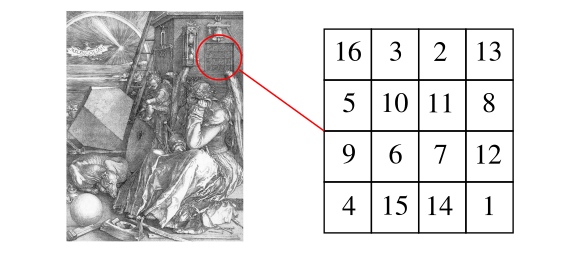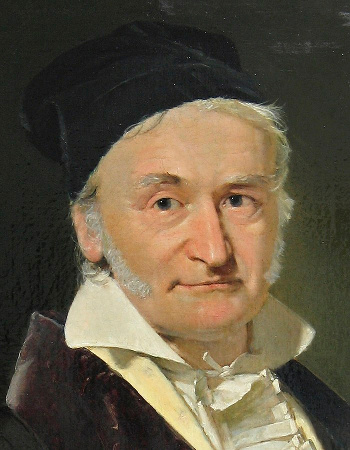Crazy Number Sequences
January 28, 2019
Mathematics may have helped to
land men on the Moon and
robots on Mars, but
mathematicians do not always keep their
pencils to the
grindstone. They agree with the
"all work, no play" adage and mix a lot of play into their mathematics. An early
historical example of such
recreational mathematics would be
magic squares, traced back more than two thousand years but surprisingly never discovered by the
Greek mathematicians.

Melencolia I, a 1514 engraving by Albrecht Dürer (1471–1528), now located at the Staatliche Kunsthalle Karlsruhe. This engraving contains a 4x4 magic square based on the number 34. The sum 34 is found in the rows, columns, diagonals, but also in each of the quadrants and the center four squares, among other places. (Via Wikimedia Commons.)
Palindromes are words or sentences that read the same forwards and backwards. A good
technological example of a palindrome is the word,
radar. The Palindrome principle can also be applied to
numbers to create
palindromic numbers. These numbers are
sequence A002113 in the
On-Line Encyclopedia of Integer Sequences (OEIS), and a few examples just below the number one million (which is obviously not a palindrome) are 990099, 991199, 992299, 993399, 994499, 995599, 996699, 997799, 998899, and 999999; and f303f, f313f, f323f, f333f, f343f, f353f, f363f, f373f, f383f, f393f, f3a3f, f3b3f, f3c3f, f3d3f, f3e3f, f3f3f, f404f, and f414f for
hexadecimal numbers These are very easily generated in a
high-level language, and my
PHP source code for such a program can be found
here.
Champernowne's constant is the apparently useless number, 0.12345678910111213141516..., which is
sequence A033307 in the OEIS. It's construction is obvious, and the concept can be applied to other
number bases as well, such as
base-2 (binary), 0.11011100101110111... Seeing the sequence of
natural numbers contained in Champernowne's constant brings to mind an interesting
anecdote from the
history of mathematics.
Early in their lives, even famous mathematicians couldn't add two-plus-two; but, unlike ordinary people, after learning that this sum was four, they quickly progressed through higher levels of
mathematical abstraction.
Carl Friedrich Gauss (1777-1855) was one such mathematician who also excelled as a
physicist. As the story goes, Gauss was an eight year old
child among other
elementary school students who were given a lengthy
mathematics problem by their
teacher. This is a common
tactic of teachers who need time to
grade homework or
tests.
The assignment was to add together all the numbers from one to a hundred. Gauss immediately arrived at the correct answer, 5050, with no written
calculation. He realized that you could pair most of the numbers, 1 with 99, 2 with 98, etc., to give you 49 sums of a hundred each. Adding the additional 100 and 50 immediately gave the answer, 5050. There's a general
formula for calculating the sum of such a series up to the number
n,

This gives us Gauss' answer when
n = 100.

Carl Friedrich Gauss (1777-1855).
Gauss has a plethora of things named after him, including a unit of magnetism, the gauss, that's been superseded by the tesla.
As I wrote in a recent article (Great Circle Routes, June 25, 2018), Gauss did an experiment in the 1820s to determine whether space was curved; that is, non-Euclidean.
He used his era's version of a laser theodolite, called a heliotrope, to survey a triangle between three mountains - Brocken, Hohenhagen, and Inselberg.
This triangle had sides of length 69, 85 and 107 kilometers, but even such a large triangle has the now known difference in the sum of angles from 180 degrees of just 0.1 picoradians.
(An 1840 oil portrait by the danish painter Christian Albrecht Jensen (1792-1870), via Wikimedia Commons)
If we write the
decimal digits 1-9 in
sequence and insert a
random addition or
multiplication operation between digits, as in
1 + 2 x 3 + 4 x 5 x 6 x 7 + 8 x 9, what range of numbers would we get? We need to remember the
the order of operations in which we always multiply before we add. In the given example, we get
919. Since there are just eight operations, we can do an exhaustive search of all 256 different possibilities. A simple PHP program (found
here) gives us the following as the minimum and maximum results:
1 x 2 + 3 + 4 + 5 + 6 + 7 + 8 + 9 = 44
1 + 2 x 3 x 4 x 5 x 6 x 7 x 8 x 9 = 362881
This serves as an introduction to a lengthy 2014 paper on
arXiv by
Inder J. Taneja, who was formerly a
professor of mathematics at the
Universidade Federal de Santa Catarina (Florianópolis, Brazil).[2] Taneja considers both ascending and descending decimal digits,
parenthetical grouping, and also adds
exponentiation to the mathematical operator mix. Also allowed are numbers formed by the
concatenation of successive digits, as the following examples show.
346 = 12345 + 6 x 7 x 8 + 9
346 = 9 x 8 + 7 + 65 x 4 + 3 x 2 + 1
514 = 1 + 23 x 4 + 56 x 7 + 89
514 = 98 + 76 x 5 + 4 + 32 x 1
6096 = 12 x 3 x 45 + 6 x 7 x 8 x 9
6096 = 9 + 87 x 65 + 432 x 1
9261 = 123 x 4 + 5 x 6 x 78 + 9
9261 = (9 + 8 + 76 + 54) x 3 x 21
By adding exponentiation, we can create numbers less than 44, as the example,
1 = 123456789, shows. However, there are numbers that can't be generated in either an increasing or decreasing digit sequence, one small number example being
52. One such larger number is
11108.
Timothy Wylie of the
University of Texas - Rio Grande Valley (Edinburg, Texas) has published a more recent paper on arXiv that examines this idea when applied to number bases other than ten.[3]

Old school numerical display - An array of IN16 Nixie tubes. The instruments in my early laboratories contained mostly analog voltmeters, often with a mirrored strip to allow an accurate reading of the indicator position without parallax. The first digital instruments had displays using these Nixie tubes. (Created from a Wikimedia Commons image by "FxDev.")
References:
- Clever Carl, NRICH team of the Millennium Mathematics Project, February, 2011.
- Inder J. Taneja, "Crazy Sequential Representation: Numbers from 1 to 11111 in terms of Increasing and Decreasing Orders of 1 to 9," arXiv, January 8, 2014.
- Tim Wylie, "Crazy Sequential Representations of Numbers for Small Bases," arXiv, October 11, 2018.
Linked Keywords: Mathematics; Apollo 11; land men on the Moon; Curiosity (rover); robots on Mars; mathematician; pencil; grindstone; All work and no play makes Jack a dull boy; "all work, no play" adage; history; historical; recreational mathematics; magic square; ancient Greece; Greek; Melencolia I; engraving; Albrecht Dürer (1471–1528); Staatliche Kunsthalle Karlsruhe; palindrome; technology; technological; radar; natural number; palindromic number; sequence A002113; On-Line Encyclopedia of Integer Sequences (OEIS); hexadecimal; high-level language; PHP; source code; palindrome.php; Champernowne's constant; sequence A033307; radix; number base; ninary number; base-2; anecdote; history of mathematics; mathematical abstraction; Carl Friedrich Gauss (1777-1855); physicist; child; elementary school; student; mathematical problem; mathematics problem; teacher; tactic (method); grading in education; homework; test (assessment); calculation; formula; plethora; things named after Carl Friedrich Gauss; unit of measurement; magnetism; gauss; tesla; experiment; spacetime; curvature of space; Euclidean space; non-Euclidean; laser; theodolite; heliotrope (instrument); surveying; survey; triangle; mountain; Brocken; Hoher Hagen (Dransfeld); Hohenhagen; Großer Inselsberg; kilometer; angle; picoradian; Christian Albrecht Jensen (1792-1870); Wikimedia Commons; decimal digit; sequence; randomness; random; addition; multiplication; operation (mathematics); order of operations; crazy seq.php; arXiv; Inder J. Taneja; professor; Universidade Federal de Santa Catarina (Florianópolis, Brazil); bracket; parenthetical grouping; exponentiation; concatenation; Timothy Wylie; University of Texas - Rio Grande Valley (Edinburg, Texas); old school; numerical digit; display; Nixie tube; scientific instrument; laboratory; galvanometer; analog voltmeter; mirror; parallax; digital instrument.